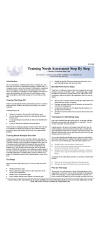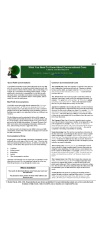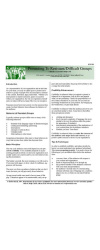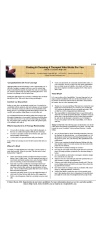By Roger Dawson
Editor’s Summary: This is excellent advice specifically aimed at negotiating terms of buying or selling services and products. The author describes what you can do to during negotiations to create the impression that the other side is winning and getting exactly what they want. Don’t miss the author’s four basic rules of negoitation.
Let’s talk about win-win negotiating. Instead of trying to dominate the other person and trick him into doing things he wouldn’t normally do, I believe that you should work with the other person to work out your problems and develop a solution with which both of you can win.
Your reaction to that may be, “Roger, you obviously don’t know much about my industry. I live in a dog-eat-dog world. The people with whom I negotiate don’t take any prisoners. They eat their young. There’s no such thing as win-win in my industry. When I’m selling I’m obviously trying to get the highest price I possibly can, and the buyer is obviously trying to get the lowest possible price. When I’m buying the reverse is true. How on Earth can we both win?”
So, let’s start out with the most important issue: What do we mean when we say win-win? Does it really mean that both sides win? Or does it mean that both sides lose equally so that it’s fair? What if each side thinks that they won and the other side lost—would that be win-win? Before you dismiss that possibility think about it more. What if you’re selling something and leave the negotiation thinking, “I won. I would have dropped the price even more if the other person had been a better negotiator”? However the other person is thinking that she won and that she would have paid more if you had been a better negotiator. So both of you think that you won and the other person lost. Is that win-win? Yes, I believe it is, as long as it’s a permanent feeling. As long as neither of you wakes up tomorrow morning thinking, “Son of a gun, now I know what he did to me. Wait until I see him again.”
That’s why I stress doing the things that service the perception that the other side won, such as:
- Don’t jump at the first offer.
- Ask for more than you expect to get.
- Flinch at the other side’s proposals.
- Avoid confrontation.
- Play Reluctant Buyer or Reluctant Seller.
- Use the Vise gambit: You’ll have to do better than that.
- Use Higher Authority and Good Guy/Bad Guy to make them think you’re on their side.
- Never offer to split the difference.
- Set aside impasse issues.
- Always ask for a trade-off and never make a concession without a reciprocal concession.
- Taper down your concessions.
- Position the other side for easy acceptance.
Besides constantly servicing the perceptions that the other side won, observe these four fundamental rules:
Rule one of win-win negotiating: Don’t narrow it down to just one issue
The first thing to learn is this: Don’t narrow the negotiation down to just one issue. If, for example, you resolve all the other issues and the only thing left to negotiate is price, somebody does have to win and somebody does have to lose. As long as you keep more than one issue on the table, you can always work trade-offs so that the other person doesn’t mind conceding on price because you are able to offer something in return.
Sometimes buyers try to treat your product as a commodity by saying, “We buy this stuff by the ton. As long as it meets our specifications we don’t mind who made it or where it comes from.” They are trying to treat this as a one issue negotiation to persuade you that the only way you can make a meaningful concession is to lower your price. When that’s the case you should do everything possible to put other issues, such as delivery, terms, packaging, and guarantees onto the table so that you can use these items for trade-offs and get away from the perception that this is a one-issue negotiation.
At a seminar, a commercial real estate sales person came up to me. He was excited because he’d almost completed negotiating a contract for a very large commercial building. “We’ve been working on it now for over a year,” he said. “And we’ve almost got it resolved. In fact, we’ve resolved everything except price, and we’re only $72,000 apart.” I flinched because I knew that now that he’d narrowed it down to one issue, then there had to be a winner and there had to be a loser. However close they may be, they were probably heading for trouble. In a one-issue negotiation, you should add other elements so that you can trade them off later and appear to be making concessions.
So if you find yourself deadlocked with a one-issue negotiation, you should try adding other issues into the mix. Fortunately, usually many more elements than just the one main issue are important in negotiations. The art of win-win negotiating is to piece together those elements like putting together a jigsaw puzzle so that both people can win. Rule one is, don’t narrow the negotiations down to just one issue. While we may resolve impasses by finding a common ground on small issues to keep the negotiation moving, you should never narrow it down to one issue.
Rule two of win-win negotiating: People are not out for the same thing
Rule number two that makes you a win-win negotiator is the understanding that people are not out for the same thing. We all have an overriding tendency to assume that other people want what we want, and because of this we believe that what’s important to us will be important to them. But that’s not true.
The biggest trap into which neophyte negotiators fall is assuming that price is the dominant issue in a negotiation. Many other elements, other than price, that are important to the other person.
You must convince her of the quality of your product or service. He needs to know that you will deliver on time.
She wants to know that you will give adequate management supervision to their account. How flexible are you on payment terms?
Does your company have the financial strength to be a partner of theirs?
Do you have the support of a well-trained and motivated work force?
These all come into play, along with half-a-dozen other factors. When you have satisfied the other person that you can meet all those requirements, then, and only then, does price become a deciding factor. So, the second key to win-win negotiating is this: Don’t assume that they want what you want. Because if you do, you further make the assumption that anything you do in the negotiations to help them get what they want helps them and hurts you.
Win-win negotiating can come about only when you understand that people don’t want the same things in the negotiation. So Power Negotiating becomes not just a matter of getting what you want, but also being concerned about the other person getting what he or she wants. One of the most powerful thoughts you can have when you’re negotiating with someone is not: ”What can I get from them?” but “What can I give them that won’t take away from my position?” Because when you give people what they want, they will give you what you want in a negotiation.
Rule three of win-win negotiating: Don’t try to get the last dollar off the table
The third key to win-win negotiating is this: Don’t be too greedy. Don’t try to get the last dollar off the table. You may feel that you triumphed, but does that help you if the other person felt that you vanquished him? That last dollar left on the table is a very expensive dollar to pick up. A man who attended my seminar in Tucson told me that he was able to buy the company that he owned because the other potential buyer made that mistake. The other person had negotiated hard and pushed the seller to the brink of frustration. As a final Nibble, the buyer said, “You are going to put new tires on that pickup truck before you transfer title aren’t you?”
That straw broke the proverbial camel’s back. The owner reacted angrily, refused to sell his company to him, and instead sold it to the man at my seminar.
So, don’t try to get it all, but leave something on the table so that the other person feels that she won also.
Rule four of win-win negotiating:
Put something back on the table The fourth key to win-win negotiating is this: Put something back on the table when the negotiation is over. I don’t mean by telling them that you’ll give them a discount over and above what they negotiated. I mean do something more than you promised to do. Give them a little extra service. Care about them a little more than you have to. Then you’ll find that the little extra for which they didn’t have to negotiate means more to them that everything for which they did have to negotiate.
Now let me recap what I believe about win-win negotiating:
People have different personality styles, and because of this, they negotiate differently. You must understand your personality style, and, if it’s different from the other person, you must adapt your style of negotiating to theirs.
The different styles mean that in a negotiation, different people have different goals, relationships, styles, faults, and different methods of getting what they want.
Winning is a perception, and by constantly servicing the perception that the other person is winning you can convince him that he has won without having to make any concessions to him.
Don’t narrow the negotiation down to just one issue.
Don’t assume that helping the other person get what he wants takes away from your position. You’re not out for the same thing. Poor negotiators try to force the other person to get off the positions that they’ve taken. Power negotiators know that even when positions are 180 degrees apart the interests of both sides can be identical, so they work to get people off their positions and concentrating on their interests.
Don’t be greedy. Don’t try to get the last dollar off the table. Put something back on the table. Do more than they bargained for.
Roger Dawson
Founder of the Power Negotiating Institute
800-932-9766
RogDawson@aol.com
http://www.rdawson.com






